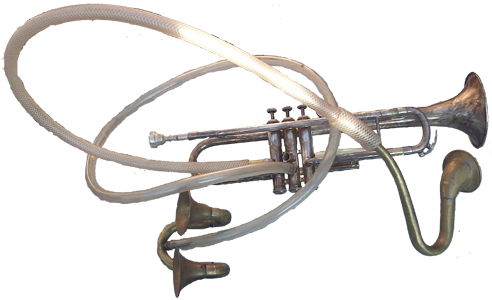Details of how I set up the trumpet with extra tubing and horns and kazoos. I have used this with my solo sets and with Brass Reality and Keith Moline
To understand how this works we have to go through it in stages. We start with an intro to how air is blown around the trumpet

When valves are pressed the air goes through an extra bit of brass tubing. That is how a trumpet plays different pitches. The diagram above shows the extra tubing each valve opens up and the direction of the air
The extra bits of brass tubing on the trumpet are known as “slides” because they can slide on and off and be adjusted to fine tune them.
What I do is pull them totally off and put other noise making devices. So if i pull off slide 3 and put a kazoo in the end. Whenever I press valve 3 the kazoo sounds
 I pull off slide 2 and stick some plastic hosepipe to extend it with a horn on the end. Now when i press valve 2 the horn sounds
I pull off slide 2 and stick some plastic hosepipe to extend it with a horn on the end. Now when i press valve 2 the horn sounds
The same with slide 1. Now when I press valve 1 another horn on the end of a plastic tube sounds. This of course means I lose some of the notes on the trumpet – but I now basically have a bugle (trumpet with no valves) and the valves all create extra sounds.
This idea can be extended. Sometimes I attach another trumpet (or cornet) to the end of slide 2, so that when I press that valve it goes into another valved instrument increasing the number of tubes and valve options.
The tubing cannot be too long before you start to lose volume and it gets very quiet. The tubes can also of course be placed in water which gives a whole new sound.
Here is a film from 1997 where I am playing the tubing set up.


